Godfrey Morgan, Viscount Tredegar, was Newport’s greatest benefactor; his name now adorns this Wetherspoon pub. The most influential family Newport has ever known, the Morgans lived in Tredegar House from the early 15th century until 1951.
Text about the Morgan family.
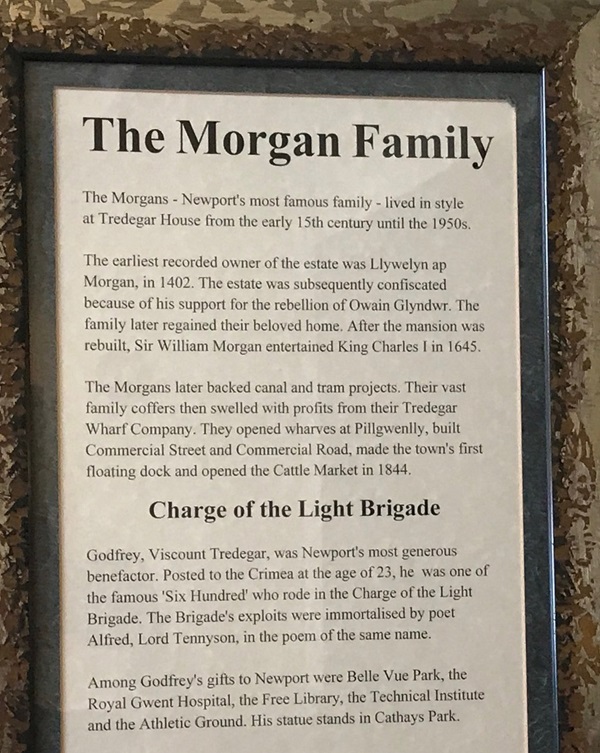
The text reads: The Morgans – Newport’s most famous family – lived in style at Tredegar House from the early 15th century until the 1950s.
The earliest recorded owner of the estate was Llywelyn ap Morgan, in 1402. The estate was subsequently confiscated because of his support for the rebellion of Owain Glyndwr. The family later regained their beloved home. After the mansion was rebuilt, Sir William entertained King Charles I in 1645.
The Morgans later backed canal and tram projects. Their vast family coffers then swelled with profits from their Tredegar Wharf Company. They opened wharves at Pillgwenlly, built Commercial Street and Commercial Road, made the town’s first floating dock and opened the Cattle Market in 1844.
Godfrey, Viscount Tredegar, was Newport’s most generous benefactor. Posted to the Crimea at the age of 23, he was one of the famous ‘Six Hundred’ who rode in the Charge of the Light Brigade. The Brigade’s exploits were immortalised by poet Alfred, Lord Tennyson, in the poem of the same name.
Among Godfrey’s gifts to Newport were Belle Vue Park, the Royal Gwent Hospital, the Free Library, the Technical Institute and the Athletic Ground. His statue stands in Cathays Park.
Prints and text about ringleaders in transport.
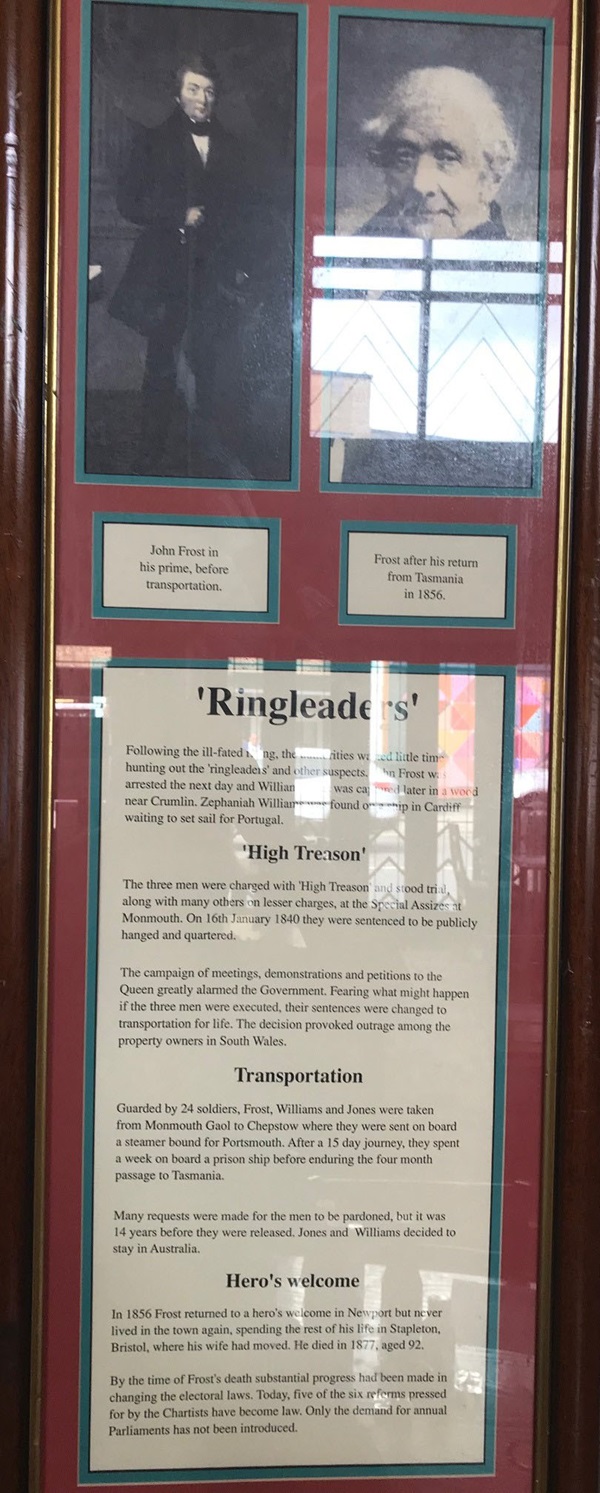
The text reads: Following the ill-fated rising, the authorities wasted little time hunting out the ‘ringleaders’ and other suspects. John Frost was arrested the next day and William was captured later in a wood near Crumlin. Zephaniah Williams was found on a ship in Cardiff waiting to set sail for Portugal.
The three men were charged with High Treason and stood trial, along with many others on lesser charges, at the Special Assizes at Monmouth. On 16 January 1840 they were sentenced to be publicly hanged and quartered.
The campaign of meetings, demonstrations and petitions to the Queen greatly alarmed the Government. Fearing what might happen if the three men were executed, their sentences were changed to transportation for life. The decision provoked outrage among the property owners in South Wales.
Guarded by 24 soldiers, Frost, Williams and Jones were taken from Monmouth Gaol to Chepstow where they were sent on board a steamer bound for Portsmouth. After a 15 day journey, they spent a week on board a prison ship before enduring the four month passage to Tasmania.
Many requests were made for the men to be pardoned, but it was 14 years before they were released. Jones and Williams decided to stay in Australia.
In 1856 Frost returned to a hero’s welcome in Newport but never lived in the town again, spending the rest of his life in Stapleton, Bristol, where his wife had moved. He died in 1877, aged 92.
By the time of Frost’s death substantial progress had been made in changing the electoral laws. Today, five of the six reforms pressed for by the Chartists have become law. Only the demand for annual Parliaments has not been introduced.
Text about WH Davies.
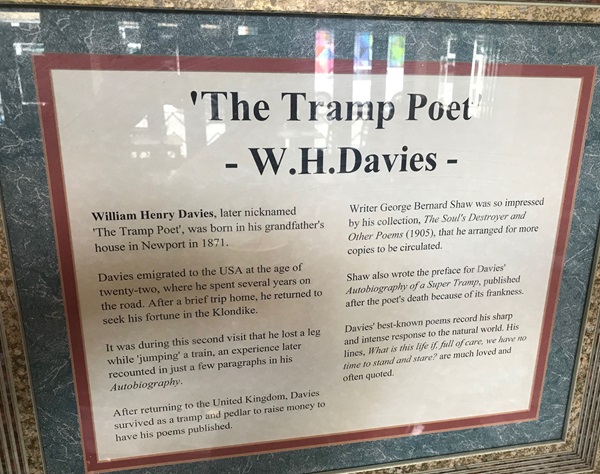
The text reads: William Henry Davies, later nicknamed ‘The Tramp Poet’, was born in his grandfather’s house in Newport in 1871.
Davies emigrated to the USA at the age of twenty-two, where he spent several years on the road. After a brief trip home, he returned to seek his fortune in the Klondike.
It was during this second visit that he lost a leg while ‘jumping’ a train, an experience later recounted in just a few paragraphs in his Autobiography.
After returning to the United Kingdom, Davies survived as a tramp and pedlar to raise money to have his poems published.
Writer George Bernard Shaw was so impressed by his collection, The Soul’s Destroyer and Other Poems (1905), that he arranged for more copies to be circulated.
Shaw also wrote the preface for Davies’ Autobiography of a Super Tramp, published after the poet’s death because of its frankness.
Davies’ best-known poems record his sharp and intense response to the natural world. His lines, What is this life if, full of care, we have no time to stand and stare? Are much loved and often quoted.
Above: WH Davies by Augustus John
Left: George Bernard Shaw.
Text about Johnny Morris.
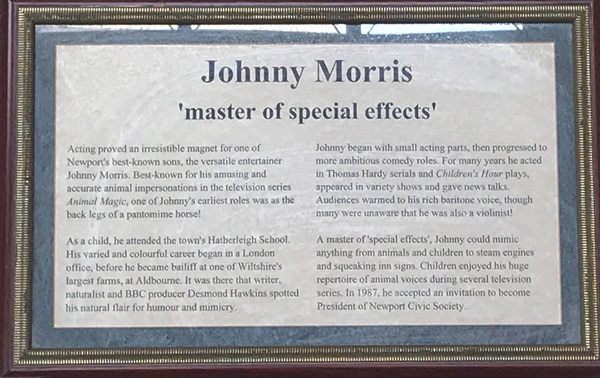
The text reads: Acting proved an irresistible magnet for one of Newport’s best-known sons, the versatile entertainer Johnny Morris. Best-known for his amusing and accurate animal impersonations in the television series Animal Magic, one of Johnny’s earliest roles was as the back legs of a pantomime horse!
As a child, he attended the town’s Hartherleigh School. His varied and colourful career began in a London office, before he became bailiff at one of Wiltshire’s largest farms, at Aldbourne. It was there that writer, naturalist and BBC producer Desmond Hawkins spotted his natural flair for humour and mimicry.
Johnny began with small acting parts, then progressed to more ambitious comedy role. For many years he acted in Thomas Hardy serials and Children’s Hour plays, appeared in variety shows and gave news talks. Audiences warmed to his rich baritone voice, though many were unaware that he was also a violinist!
A master of ‘special effects’, Johnny could mimic anything from animals and children to steam engines and squeaking inn signs. Children enjoyed his huge repertoire of animal voices during several television series. In 1987, he accepted an invitation to become President of Newport Civic Society.
A print and text about the Newport Transporter.
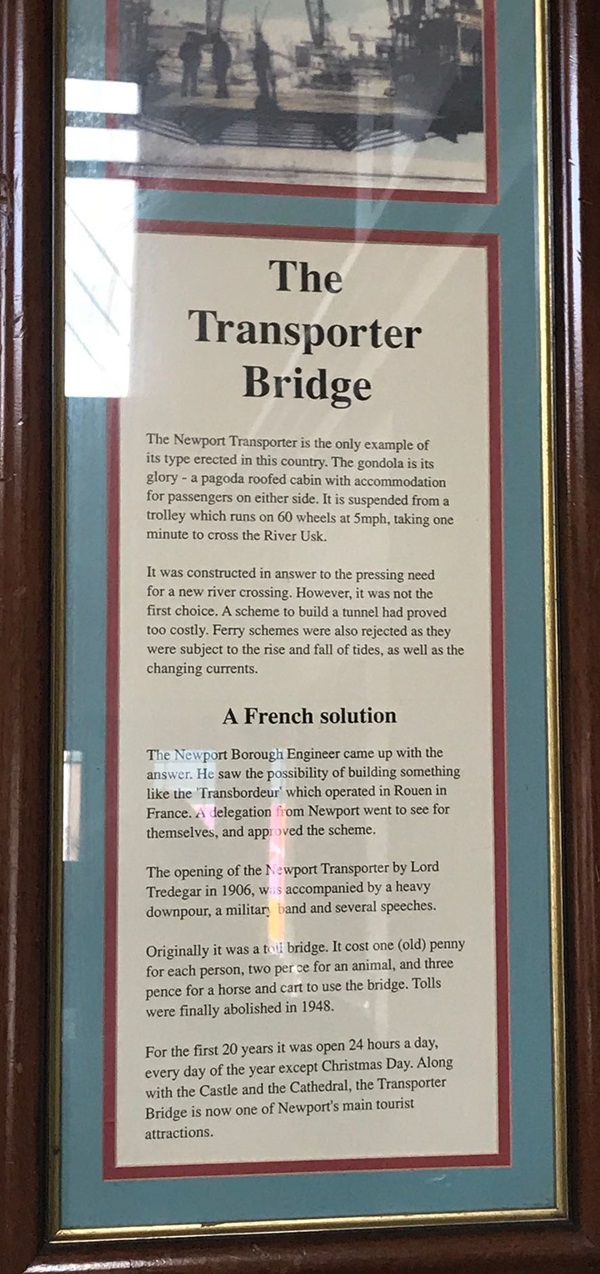
The text reads: The Newport Transporter is the only example of its type erected in this country. The gondola is its glory – a pagoda roofed cabin with accommodation for passengers on either side. It is suspended from a trolley which runs on 60 wheels at 5mph, taking one minute to cross the River Usk.
It was constructed in answer to the pressing need for a new river crossing. However, it was not the first choice. A scheme to build a tunnel had proved too costly. Ferry schemes were also rejected as they were subject to the rise and fall of tides, as well as the changing currents.
The Newport Borough Engineer came up with the answer. He saw the possibility of building something like the ‘Transbordeur’ which operated in Rouen in France. A delegation from Newport went to see for themselves, and approved the scheme.
The opening of the Newport Transporter by Lord Tredegar in 1906, was accompanied by a heavy downpour, a military band and several speeches.
Originally it was a toll bridge. It cost one (old) penny for each person, two pence for an animal, and three pence for a horse and cart to use the bridge. Tolls were finally abolished in 1948.
For the first 20 years it was open 24 hours a day, every day of the year except Christmas Day. Along with the Castle and the Cathedral, the Transporter Bridge is now one of Newport’s main tourist attractions.
Prints and text about the Chartists.
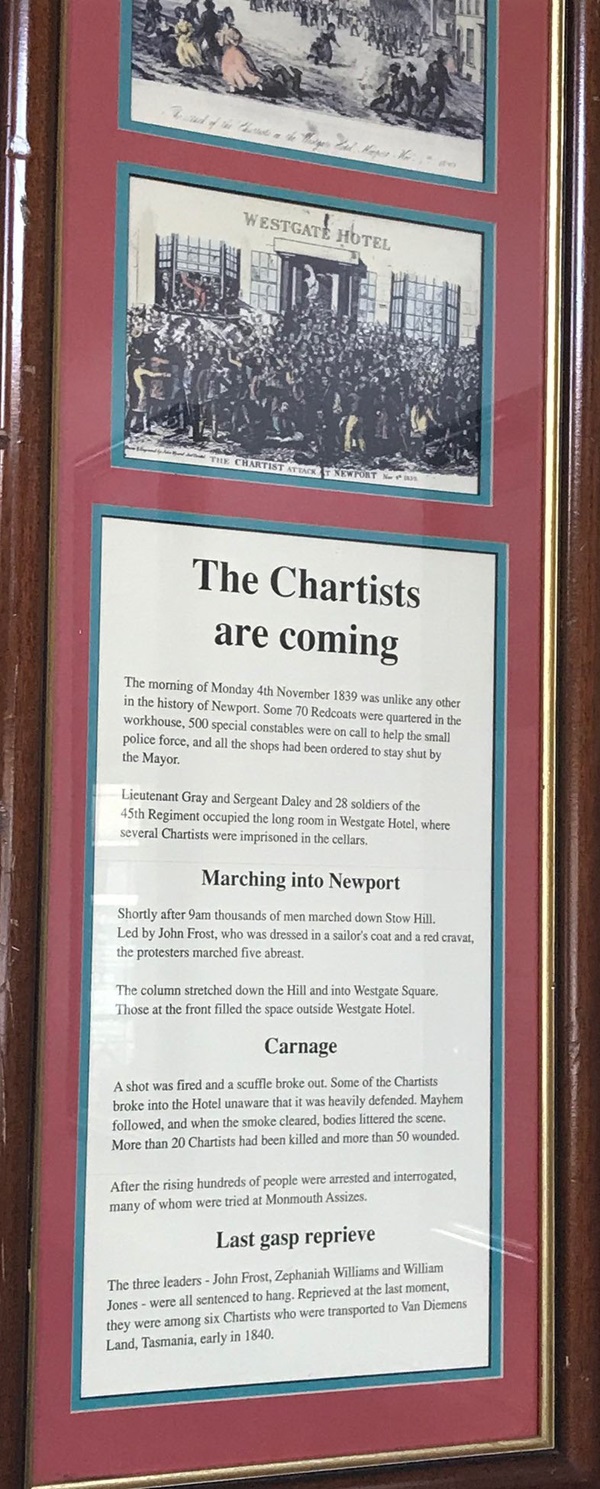
The text reads: The morning of Monday 4 November 1839 was unlike any other in the history of Newport. Some 70 Redcoats were quartered in the workhouse, 500 special constables were on call to help the small police force, and all the shops had been ordered to stay shut by the mayor.
Lieutenant Gray and Sergeant Daley and 28 soldiers of the 45th Regiment occupied the long room in Westgate Hotel, where several Chartists were imprisoned in the cellars.
Shortly after 9am thousands of men marched down Stow Hill. Led by John Frost, who was dressed in a sailor’s coat and a red cravat, the protesters marched five abreast.
A shot was fired and a scuffle broke out. Some of the Chartists broke into the Hotel unaware that it was heavily defended. Mayhem followed, and when the smoke cleared, bodies littered the scene. More than 20 Chartists had been killed and more than 50 wounded.
After the rising hundreds of people were arrested and interrogated, many of whom were tried at Monmouth Assizes.
The three leaders – John Frost, Zephaniah Williams and William Jones – were all sentenced to hang. Reprieved at the last moment, they were among six Chartists who were transported to Van Diemens Land, Tasmania, Early in 1840.
A print and text about rugby superstar, Arthur Joseph Gould.

The text reads: Back in the 1890s, Arthur Joseph Gould was a rugby superstar. He began his playing career here in Newport in 1882.
His first game was against Weston-Super-Mare, when he was just 16 years old. Gould, who played for several other clubs, also finished his career in Newport.
During his spell at Newport he scored 554 points, including 136 tries – 36 in a single season. He also made 27 appearances for Wales, and captained his country 18 times.
As a tribute to a great player a collection was organised to purchase the deeds to 6 Llanthewy Road, Newport, the house in which Gould was living at the time.
However, the rugby authorities deemed this a violation of the amateur code.
Meanwhile Gould received the deeds to his house. The English, Scottish and Irish rugby authorities were far from happy, and cancelled their fixtures against the Welsh national team.
Arthur Gould died in 1919. He was taken ill at work, and died at his house in Newport, which had sparked off the row between the rugby associations of the four ‘home’ countries.
Text about the Maindee Cinema.
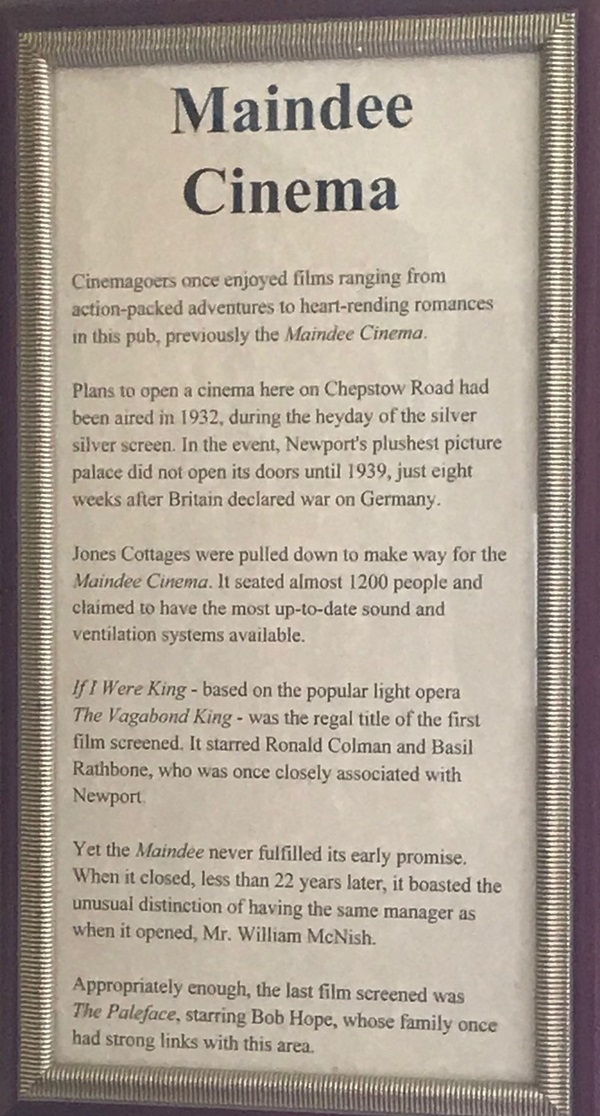
The text reads: Cinemagoers once enjoyed films ranging from action-packed adventures to heart-rending romances in this pub, previously Maindee Cinema.
Plans to open a cinema here on Chepstow Road had been aired in 1932, during the heyday of the silver screen. In the event, Newport’s plushest picture palace did not open its doors until 1939, just eight weeks after Britain declared war on Germany.
Jones Cottages were pulled down to make way for the Maindee Cinema. It seated almost 1200 people and claimed to have the most up-to-date sound and ventilation systems available.
If I Were King – based on the popular light opera The Vagabond King – was the regal title of the first film screened. It starred Ronald Colman and Basil Rathbone, who was once closely associated with Newport.
Yet the Maindee never fulfilled its early promise. When it closed, less than 22 years later, it boasted the unusual distinction of having the same manager as when it opened, Mr William McNish.
Appropriately enough, the last film screened was The Paleface, starring Bob Hope, who family once had strong links with this area.
An old photograph of this former cinema.
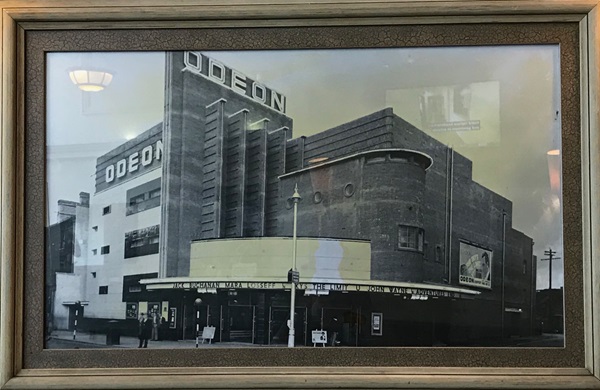
An old photograph of High Street, Newport.
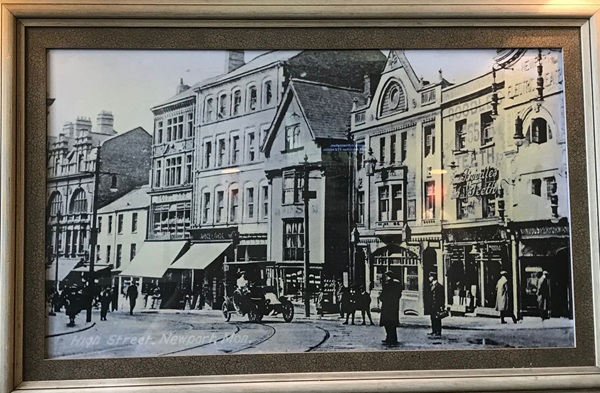
An old photograph of The Coliseum.
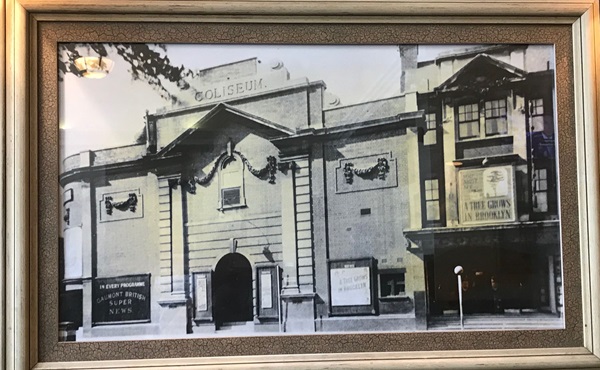
An old photograph of the inside of this cinema.
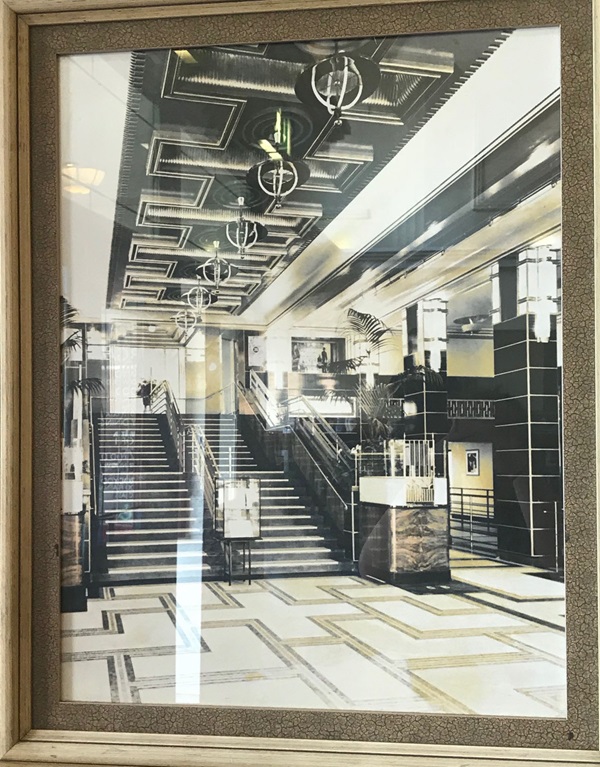
An old photograph of the Lyceum Theatre, Newport.
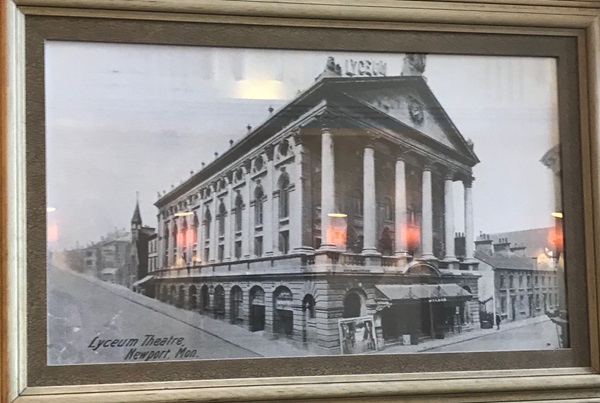
If you have information on the history of this pub, then we’d like you to share it with us. Please e-mail all information to: pubhistories@jdwetherspoon.co.uk